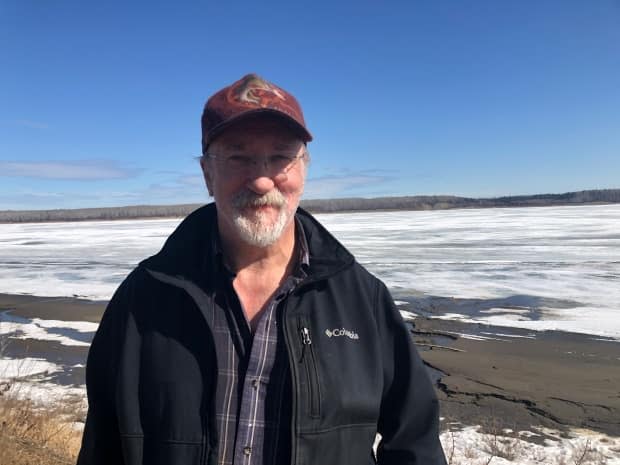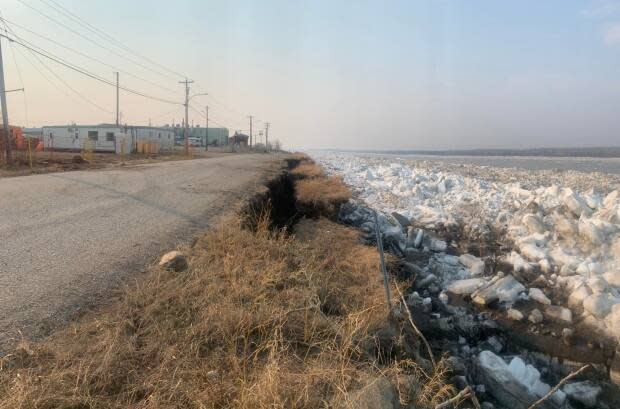At the 'tail end' of 2021 flood recovery, Fort Simpson, N.W.T., looks to the future

On a sunny Tuesday evening in Fort Simpson, N.W.T., Derek and Julia Erasmus cook up a dinner of waffles and sausages as their two young daughters play outside.
Watching them, you wouldn't know just how difficult the past two years have been. They were one of 10 families who lost their house when the community flooded in 2021.
"It's kind of just a huge life-changing event," Derek said. "We kind of thought we were going to retire in that house some day … then those plans were all gone after that."
The family has managed to carry on despite that, he said, and they've made peace with what happened.
They've settled in nicely at a rental house and are just waiting on a property issue to be resolved before moving into their official replacement home – hopefully, sometime soon.
"We're just getting back to our regular lives," Julia said. "It's great."

Back to normal
It's a feeling shared amongst the wider community, according to Fort Simpson Mayor Sean Whelly.
He described the community as being at the "tail end" of the recovery process. The wreckage has been cleaned up, most buildings have had the necessary repairs or replacements, and the majority of residents who lost their house (save for one or two) are now moved in.
With order restored — and the risk of flooding this year now officially passed — the wounds of the 2021 flood that displaced hundreds and destroyed homes have started to heal.
"Last year, there was a lot of anxiety, even though the water was lower, because we'd just gone through the flood," Whelly said. "This year … it feels a lot more normal, and people are just getting along with their lives a lot more.
"It's good to be concerned, but not [let it] consume you."

Kele Antoine, chief of Łı́ı́dlı̨ı̨ Kų́ę́ First Nation, attributes the relative calm to the way local governments have worked together to prepare for future emergencies.
The village has since hired a full-time fire chief responsible for coordinating the flood response, for instance, and installed markers along the riverbank to better gauge water levels.
"After that flood, we kind of knew what to expect, so we took our plans apart and strengthened them, delegating certain duties to the right people," Antoine said. "Just having a good, robust plan has really done wonders for those nerves. You can definitely feel it."
For its part, Antoine said the First Nation has been trying to boost spirits over the past several months with healthy activities such as feasts, sewing circles and culture camps.
It has also been working with the Canadian Red Cross to facilitate donations of recreational equipment that will be distributed throughout the community. Last month, a shipment of 300 bicycles and 60 kayaks arrived — just in time for the summer.
"It's been incredible to get this kind of support from an organization like the Red Cross," Antoine said. "It's really nice to see large organizations from the south coming up here and helping out a small community like ours."

Vulnerable infrastructure, erosion are continued problems
There are still several challenges weighing heavily on people's minds.
Both Whelly and Antoine repeated the need to move key infrastructure, such as the power plant and water treatment facility, off the flood-prone island and up to higher ground.
Though they identified this problem shortly after 2021, as it stands, there are no concrete timelines for when that work will happen.
Muaz Hassan, a village councillor, is particularly concerned about the health centre and long-term facility for elders, which are both on the island as well. He said the threat of flooding each spring creates undue stress for those in care.
"We know that some elders who witnessed the flood [in] 1963 … are in the long-term [facility]," Hassan said, referring to the last time Fort Simpson experienced a big flood. "The psychological distress to people who witnessed that is really hard.

"So, I think this is one of the priorities which the government should think about."
Another challenge that has cropped up again this year is erosion along the riverbanks.
"We'd been going decades with very little erosion, and we suddenly saw almost galloping erosion … to the point where we've got water lines that are now in danger of being exposed, hanging up in the middle of the road," Whelly said. "I think that's due to climate change."
He estimates the community has lost about six feet of earth in some areas of the riverbank in the past two years, giving the need to relocate infrastructure a renewed sense of urgency.
Bob Norwegian is a Dehcho Dene elder who has studied the ice for decades and keeps records on its movement each spring.
To him, the way break-up has begun to eat away at the riverbanks isn't particularly surprising. He described the island as "an iceberg" that's slowly sinking every year, and suggested that in two centuries or so, it may not even exist any more.
"I keep telling people we should move across [to the other side of the river]," he said. "It's all good land, gravel and rocks. This side is sort of mushy, like muskeg-y, and there's nothing but sand."
To protect against future erosion, the Village of Fort Simpson is now applying for $75 million from the federal government to fortify the shoreline with rocks and other embankment materials.
Whelly said they hope to receive some of it as soon as this year.
'The strength that's going to carry us'
Back at the Erasmus household, Derek and Julia reflected on lessons learned since 2021.
"We lost a lot of stuff, and our lives will never be the same, but all of that stuff can be replaced," he said. "We were just happy that everybody was OK — and the community came together. It was nice to see."
For many residents, the way Fort Simpson rallied during a time of crisis continues to be what sticks out all these months later. People pitched in to help with clean-up, made sure to check in on one another, and lent a helping hand wherever they could.
And even though climate change might make the future somewhat uncertain, Whelly said that continues to give him hope.
"No matter what kind of hardships we might face or challenges in the future," he says, "I think the people of Fort Simpson are really the strength that's going to carry us forward."


